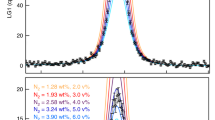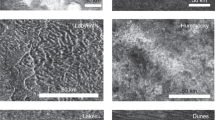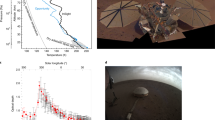Abstract
On the basis of previous ground-based and fly-by information, we knew that Titan's atmosphere was mainly nitrogen, with some methane, but its temperature and pressure profiles were poorly constrained because of uncertainties in the detailed composition. The extent of atmospheric electricity (‘lightning’) was also hitherto unknown. Here we report the temperature and density profiles, as determined by the Huygens Atmospheric Structure Instrument (HASI), from an altitude of 1,400 km down to the surface. In the upper part of the atmosphere, the temperature and density were both higher than expected. There is a lower ionospheric layer between 140 km and 40 km, with electrical conductivity peaking near 60 km. We may also have seen the signature of lightning. At the surface, the temperature was 93.65 ± 0.25 K, and the pressure was 1,467 ± 1 hPa.
This is a preview of subscription content, access via your institution
Access options
Subscribe to this journal
Receive 51 print issues and online access
$199.00 per year
only $3.90 per issue
Buy this article
- Purchase on Springer Link
- Instant access to full article PDF
Prices may be subject to local taxes which are calculated during checkout









Similar content being viewed by others
References
McKay, C. P., Pollack, J. B. & Courtin, R. The thermal structure of Titan's atmosphere. Icarus 80, 23–53 (1989)
Lindal, G. F. et al. The atmosphere of Titan—an analysis of the Voyager 1 radio occultation measurements. Icarus 53, 348–363 (1983)
Lellouch, E. et al. Titan's atmosphere and hypothesized ocean: a reanalysis of the Voyager 1 radio-occultation and IRIS 7.7 µm data. Icarus 79, 328–349 (1989)
Vervack, R. J., Sandel, B. R. & Strobel, D. F. New perspectives on Titan's upper atmosphere from a reanalysis of the Voyager 1 UVS solar occultations. Icarus 170, 91–112 (2004)
Coustenis, A. et al. Titan's atmosphere from ISO mid-infrared spectroscopy. Icarus 161, 383–403 (2003)
Hubbard, W. B. et al. Results for Titan's atmosphere from its occultation of 28 Sagittarii. Nature 343, 353–355 (1990)
Sicardy, B. et al. The structure of Titan's stratosphere from the 28 Sgr occultation. Icarus 142, 357–390 (1999)
Tracadas, P. W., Hammel, H. B., Thomas-Osip, J. E. & Elliot, J. L. Probing Titan's atmosphere with the 1995 August stellar occultation. Icarus 153, 285–294 (2001)
Bouchez, A. H. et al. Adaptive optics imaging of a double stellar occultation by Titan. Bull. Am. Astron. Soc. 34, 881 (2002)
Sicardy, B. et al. The two stellar occultations of November 14, 2003: revealing Titan's stratosphere at sub-km resolution. Bull. Am. Astron. Soc. 36, 1119 (2004)
Lellouch, E., Hunten, D., Kockarts, G. & Coustenis, A. Titan's thermosphere profile. Icarus 83, 308–324 (1990)
Yelle, R. V. Non-LTE models of Titan's upper atmosphere. Astrophys. J. 383, 380–400 (1991)
Yelle, R. V., Strobel, D. F., Lellouch, E. & Gautier, D. Engineering Models for Titan's Atmosphere 243–256 (ESA SP-1177, European Space Agency, Noordwijk, 1997)
Campbell, D. B., Black, G. J., Carter, L. M. & Ostro, S. J. Radar evidence for liquid surfaces on Titan. Science 302, 431–434 (2003)
Coustenis, A. et al. Maps of Titan's surface from 1 to 2.5 µm. Icarus 177, 89–105 (2005)
Meier, R., Smith, B. A., Owen, T. C. & Terrile, R. J. The surface of Titan from NICMOS observations with the Hubble Space Telescope. Icarus 145, 462–473 (2000)
Porco, C. C. et al. Imaging of Titan from the Cassini spacecraft. Nature 434, 159–168 (2005)
Brown, R. H. et al. Cassini Visual and Infrared Mapping Spectrometer (VIMS): Results for the SOI- and near-SOI period of the Cassini orbital tour. Astron. Astrophys. (submitted)
Elachi, C. et al. Cassini radar views the surface of Titan. Science 308, 970–974 (2005)
Grard, R. et al. An experimental investigation of atmospheric electricity and lightning activity to be performed during the descent of the Huygens probe onto Titan. J. Atmos. Terr. Phys. 57, 575–578 (1995)
Desch, S. J., Borucki, W. J., Russell, C. T. & Bar-Nun, A. Progress in planetary lightning. Rep. Prog. Phys. 65, 955–997 (2002)
Tokano, T., Molina-Cuberos, G. J., Lammer, H. & Stumptner, W. Modelling of thunderclouds and lightning generation on Titan. Planet. Space Sci. 49, 539–560 (2001)
Lebreton, J.-P. & Matson, D. L. The Huygens probe: science, payload and mission overview. Space Sci. Rev. 104, 59–100 (2002)
Fulchignoni, M. et al. The characterization of Titan's atmospheric physical properties by the Huygens Atmospheric Structure Instrument (HASI). Space Sci. Rev. 104, 395–431 (2002)
Zarnecki, J. C. et al. In-Flight Performances of the Servo Accelerometer and Implication for Results at Titan 71–76 (ESA SP-544, European Space Agency, Noordwijk, 2004)
Lebreton, J. P. et al. An overview of the descent and landing of the Huygens probe on Titan. Nature doi:10.1038/nature04347 (this issue)
Ruffino, G. et al. The temperature sensor on the Huygens probe for the Cassini mission: Design, manufacture, calibration and tests of the laboratory prototype. Planet. Space Sci. 44–10, 1149–1162 (1996)
Harri, A.-M. et al. Scientific objectives and implementation of the Pressure Profile Instrument (PPI/HASI) for the Huygens spacecraft. Planet. Space Sci. 46, 1383–1392 (1998)
Mäkinen, T. Processing the HASI measurements. Adv. Space Res. 17, 217–222 (1996)
Niemann, H. B. et al. The abundances of constituents of Titan's atmosphere from the GCMS instrument on the Huygens probe. Nature doi:10.1038/nature04122 (this issue)
Hinson, D. P. & Tyler, G. L. Internal gravity waves in Titan's atmosphere observed by Voyager radio occultation. Icarus 54, 337–352 (1983)
Friedson, A. J. Gravity waves in Titan's atmosphere. Icarus 109, 40–57 (1994)
Bird, M. K. et al. The vertical profile of winds on Titan. Nature doi:10.1038/nature04060 (this issue)
Molina-Cuberos, G. J., López-Moreno, J. J., Rodrigo, R. & Lara, L. M. Chemistry of the galactic cosmic ray induced ionosphere of Titan. J. Geophys. Res. 104, 21997–22024 (1999)
Borucki, W. J. et al. Predictions of the electrical conductivity and charging of the aerosols in Titan's atmosphere. Icarus 72, 604–622 (1987)
Borucki, W. J., Whitten, R. C., Bakes, E. L. O., Barth, E. & Tripathi, S. Predictions of the electrical conductivity and charging of the aerosols in Titan's atmosphere. Icarus (in the press)
Molina-Cuberos, G. J., López-Moreno, J. J., Rodrigo, R. & Schwingenschuh, K. Capability of the Cassini/Huygens PWA-HASI to measure electrical conductivity in Titan. Adv. Space Res. 28, 1511–1516 (2001)
Schwingenschuh, K. et al. Propagation of electromagnetic waves in the lower ionosphere of Titan. Adv. Space Res. 28, 1505–1510 (2001)
Nickolaenko, A. P., Besser, B. P. & Schwingenschuh, K. Model computations of Schumann resonance on Titan. Planet. Space Sci. 51, 853–862 (2003)
Morente, J. A., Molina-Cuberos, G. J., Portí, J. A., Schwingenschuh, K. & Besser, B. P. A study of the propagation of electromagnetic waves in Titan's atmosphere with the TLM numerical method. Icarus 162, 374–384 (2003)
Lunine, J. I., Stevenson, D. J. & Yung, Y. L. Ethane ocean on Titan. Science 222, 1229–1230 (1983)
Zarnecki, J. C. et al. A soft solid surface on Titan as revealed by the Huygens Surface Science Package. Nature doi:10.1038/nature04211 (this issue)
Hamelin, M. et al. Surface and sub-surface electrical measurement of Titan with the PWA-HASI experiment on Huygens. Adv. Space Res. 26, 1697–1704 (2000)
Coustenis, A. & Bézard, B. Titan's atmosphere from Voyager infrared observations. IV. Latitudinal variations of temperature and composition. Icarus 115, 126–140 (1995)
Flasar, F. M. et al. Titan's atmospheric temperatures, winds, and composition. Science 308, 975–978 (2005)
Brown, M. E., Bouchez, A. H. & Griffith, C. A. Direct detection of variable tropospheric clouds near Titan's south pole. Nature 420, 7995–7997 (2002)
Tokano, T. Meteorological assessment of the surface temperatures on Titan: constraints on the surface type. Icarus 173, 222–242 (2005)
Kliore, A. J. et al. Cassini Radio Science. Space Sci. Rev. 115, 1–70 (2004)
Tomasko, M. G. et al. Rain, winds and haze during the Huygens probe's descent to Titan's surface. Nature doi:10.1038/nature04126 (this issue)
Ksanfomaliti, L. V. et al. Acoustic measurements of the wind velocity at the Venera 13 and Venera 14 landing sites. Sov. Astron. Lett 8(4), 227–229 (1982)
Acknowledgements
We thank the following people for their contributions to the realization of the HASI experiment: A. Buccheri, R. DeVidi, and M. Cosi of Galileo Avionica, A. Aboudan, S. Bastianello and M. Fabris of CISAS, M. Chabassière of LPCE, V. Brown, J.M. Jeronimo and L.M. Lara of IAA, R. Hofe of IWF, A. Smit, L. Smit and J. Van der Hooke from RSSD-ESTEC, H. Jolly from the UK, R. Pellinen, G. Leppelmeier, T. Siili, P. Salminen from FMI, and at the Aerodynamics Laboratory of Helsinki University of Technology T. Siikonen and B. Fagerström. HASI has been realised and operated by CISAS under a contract with the Italian Space Agency (ASI), with the participation of RSSD, FMI, IAA, IWF, LPCE and PSSRI sponsored by the respective agencies: ESA, TEKES, CSIC, BM:BWK, CNES and PPARC. We also acknowledge the long years of work by some hundreds of people in the development and design of the Huygens probe. The Huygens probe is part of the Cassini-Huygens mission, a joint endeavour of the National Aeronautics and Space Administration (NASA), the European Space Agency (ESA) and the Italian Space Agency (ASI).
Author information
Authors and Affiliations
Corresponding author
Ethics declarations
Competing interests
Reprints and permissions information is available at npg.nature.com/reprintsandpermissions. The authors declare no competing financial interests.
Rights and permissions
About this article
Cite this article
Fulchignoni, M., Ferri, F., Angrilli, F. et al. In situ measurements of the physical characteristics of Titan's environment. Nature 438, 785–791 (2005). https://doi.org/10.1038/nature04314
Received:
Accepted:
Published:
Issue Date:
DOI: https://doi.org/10.1038/nature04314
This article is cited by
-
Science goals and new mission concepts for future exploration of Titan’s atmosphere, geology and habitability: titan POlar scout/orbitEr and in situ lake lander and DrONe explorer (POSEIDON)
Experimental Astronomy (2022)
-
Reference Model Payload for Ice Giant Entry Probe Missions
Space Science Reviews (2020)
-
The Atmospheric Structure of the Ice Giant Planets from In Situ Measurements by Entry Probes
Space Science Reviews (2020)
Comments
By submitting a comment you agree to abide by our Terms and Community Guidelines. If you find something abusive or that does not comply with our terms or guidelines please flag it as inappropriate.



